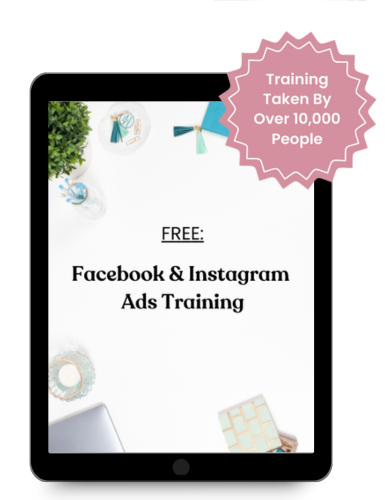The 2 AM Question That's Costing You Months of Progress
Your launch just ended. You made some sales—maybe even a few thousand dollars—but nowhere near what you hoped for.
Now you're lying awake at 2 AM thinking: Should I scrap this whole thing and try a completely different strategy?
Maybe someone told you webinars are dead and you should do a challenge instead. Or that video series convert better. Or that you need a completely different offer entirely.
So you're wondering: Do I start over from scratch? Or do I just need to fix what I have?
Here's the truth that could save you months (or even years) of wasted effort:
Most course creators start over when they should be optimizing. And that constant starting-over is exactly what's keeping them stuck.
This decision framework will help you know exactly which path you're on—and what to do next.
Estimated reading time: 18 minutes
💡 Want the full picture? This article goes hand-in-hand with Episode 322: The Worst Business Advice I Got and Why I'm Grateful for It Today of The Launch Lounge Podcast.
Pop in your earbuds and get the deeper dive.
👉 [Listen to the companion episode here]
Why This Decision Matters So Much (And Why Most Course Creators Get It Wrong)
Every time you start completely over, something critical happens:
- You lose all the data you collected
- You lose the momentum you built
- You lose the learning from what DID work
- You reset your timeline by 3-6 months
- You waste money rebuilding what wasn't actually broken
But here's the flip side: Sometimes you DO need to pivot.
Sometimes the foundation is wrong. Sometimes your offer isn't positioned correctly, or you're talking to the wrong audience. Sometimes the strategy itself just doesn't fit your market.
The costly mistake isn't pivoting when you should—it's not knowing the difference.
I learned this the hard way.
I made $2,000 on my first webinar launch with about $400 in ad spend. Instead of optimizing what I had, I quit entirely. Then when I came back months later, I started from scratch with a completely different strategy. Then another. Then another.
I wasted two years starting over when all I needed to do was make my original strategy better.
Don't make my mistake.
The Framework: 5 Questions That Tell You What to Do Next
Work through these five questions in order. By the end, you'll know exactly whether to optimize or pivot your course launch strategy.
Question 1: Did Anyone Buy?
This is your foundational question.
If the answer is yes—even if it was just one person, even if it was just $500—you have proof of concept. Your offer works. People want what you're selling.
If YES: Go to Question 2 (You're likely in optimization mode)
If NO: Answer this follow-up: Did anyone show up to your sales event (webinar/challenge/workshop)?
- If people showed up but didn't buy: Your offer or messaging needs work, but your funnel is getting people there. Go to Question 2.
- If no one showed up at all: Go to Question 5. You likely have a traffic or attraction problem, not an offer problem.
Question 2: Where Did People Drop Off in Your Launch Funnel?
This is where your data becomes your roadmap.
Look at your funnel and identify the biggest leak. This is critical information—it tells you exactly what to fix.
A. Did people see your ads but NOT opt-in to your lead magnet/webinar?
Leak location: Landing page, offer clarity, or ad-to-page disconnect
What this means: Your traffic is fine, but your promise isn't compelling enough or doesn't match what they expected from your ad.
Your fix:
- Optimize your landing page headline
- Make your promise clearer and more specific
- Ensure your ad message matches your landing page message exactly
Decision: OPTIMIZE (don't start over)
B. Did people opt-in but NOT show up to your event?
Leak location: Reminder email sequence or value perception
What this means: They were interested initially but forgot, got busy, or didn't think it was valuable enough to prioritize.
Your fix:
- Improve your reminder emails (add urgency, not just reminders)
- Add a show-up incentive (bonus, exclusive content, etc.)
- Build more anticipation in your emails between opt-in and event
Decision: OPTIMIZE (don't start over)
C. Did people show up but NOT buy?
Leak location: Your offer, your pitch, your proof, or your price-to-value ratio
What this means: You got them there (that's huge!) but something in your presentation didn't convert them from interested to invested.
Your fix: This one requires more diagnosis—go to Question 3
Decision: Likely OPTIMIZE, but Question 3 will confirm
D. Did people buy but very few (under 3% conversion)?
Leak location: Probably your offer positioning or audience match
What this means: Some people saw enough value to buy, but most didn't—this suggests your messaging or positioning needs refinement.
Your fix: Go to Question 3
Decision: Likely OPTIMIZE, but might need offer repositioning
Question 3: What Objections Came Up During Your Launch?
If people showed up but didn't buy, or if very few bought, your objections are your goldmine.
Review everything:
- Questions people asked during your live event
- Replies to your sales emails
- DMs you received during the launch
- What people said when they said “not right now”
The patterns in these objections reveal exactly what's blocking your conversions.
“I need to think about it” / “The timing isn't right”
What it really means: They're not convinced the transformation is worth the investment, or they don't believe they can achieve it.
Your fix:
- Add more proof (testimonials, case studies)
- Show them exactly what they'll achieve
- Address their specific doubts about whether this will work for THEM
Decision: OPTIMIZE your sales messaging and proof
“I can't afford it”
What it really means: Either (1) genuinely outside their budget, or (2) they don't see enough value to justify the price.
Your fix:
- If the pattern is widespread, either you're talking to the wrong audience (wrong traffic source) or you haven't built enough value
- Add more value builders: bonuses, guarantees, payment plans
- Show ROI clearly
Decision: OPTIMIZE your value stack and messaging (or revisit your targeting if everyone has this objection)
“I'm not sure this is right for me” / “Will this work for my situation?”
What it really means: Your messaging is too vague or too broad—they don't see themselves in your solution.
Your fix:
- Get more specific about who it's for
- Add more specific examples and use cases
- Address their exact situation in your pitch
Decision: OPTIMIZE your messaging to be more specific
“I've tried things like this before and they didn't work”
What it really means: They don't understand how your method is different, or you haven't differentiated yourself from other solutions.
Your fix:
- Clarify your unique methodology
- Show why your approach is different
- Address what makes this work when other things failed
Decision: OPTIMIZE your positioning and differentiation
Very few or no questions at all
What it really means: Either (1) the wrong audience showed up, or (2) your presentation didn't engage them enough to care.
Your fix:
- Review your content—was it valuable enough?
- Did it create desire?
- Did you show the transformation clearly?
Decision: OPTIMIZE your event content and engagement
Question 4: Is This the Same Strategy You've Tried 3+ Times?
This is your pattern-interrupt question.
If you've run the SAME strategy 3 or more times and optimized the weak points each time, but you're still not seeing improvement, this might be a signal to pivot.
Not because the strategy is bad, but because:
- Your audience might not resonate with this format
- Your offer might need repositioning
- Your messaging might need a complete refresh
- You might be in the wrong market
If you've only tried this strategy 1-2 times:
You haven't given it enough iterations to know if it works. Most successful course creators didn't nail it on launch #1 or even launch #2. Keep optimizing.
Decision checkpoint:
- 1-2 launches: OPTIMIZE and run it again
- 3+ launches with optimization each time: Consider a PIVOT (but read Question 5 first)
Question 5: Do You Have the Right Foundation?
Before you pivot your entire strategy, check these foundational elements:
☐ Audience Match
Are you talking to people who actually have the problem you solve AND can afford your solution?
- If NO: You don't need a new strategy—you need different traffic sources or different messaging to attract the right people
- If YES: Continue checklist
☐ Clear Transformation
Can someone in 10 seconds understand what transformation you provide and who it's for?
- If NO: You don't need a new strategy—you need clearer messaging about what you actually do
- If YES: Continue checklist
☐ Proof It Works
Do you have testimonials, case studies, or results that prove your method works?
- If NO: You might need to get some wins first—consider beta testing, working with clients one-on-one, or offering it at a lower price point to build proof
- If YES: Continue checklist
☐ Offer-Market Fit
Does your offer solve a problem people are actively looking for solutions to AND willing to pay for?
- If NO: This is your pivot point—you might need to reposition your offer or change what you're selling
- If YES: Continue checklist
☐ You Can Explain Your Unique Method
Can you articulate why your approach is different/better than other solutions?
- If NO: You need to develop your unique positioning—this doesn't require starting over with a new strategy
- If YES: You have solid foundations
If you checked YES to all of these: Your foundation is solid. OPTIMIZE your current strategy.
If you checked NO to 2 or more: You need to fix these foundational issues before you'll see results with ANY strategy. This is your real work.
Your Decision Tree: Which Path Are You On?
PATH A: OPTIMIZE (Don't Start Over)
You're on this path if:
✅ You made at least one sale
✅ You can identify a specific leak in your funnel
✅ You've only tried this 1-2 times
✅ Your foundations are solid (passed Question 5)
What to do next:
- Fix the ONE biggest leak in your funnel (from Question 2)
- Address the top 2-3 objections (from Question 3)
- Run the same strategy again within 60-90 days
- Track your three key metrics: views → opt-ins → sales
- Compare to last time and optimize the next weak point
PATH B: FIX FOUNDATIONS FIRST (Then Optimize)
You're on this path if:
⚠️ You failed 2+ items in Question 5
⚠️ You're getting traffic but wrong audience
⚠️ People are confused about what you do
What to do next:
- Don't launch again yet
- Fix your foundational issues: clarify your messaging, reposition your offer, get proof if you don't have it
- Test your new positioning with your audience before building a whole new funnel
- Once foundations are solid, return to PATH A
PATH C: STRATEGIC PIVOT (Start Fresh)
You're on this path ONLY if:
❌ You've run this 3+ times with optimization each time
❌ Your foundations are solid but results aren't improving
❌ You've tested different messaging, different proof, different pricing—and nothing moves the needle
What to do next:
- Before you pivot, get external feedback—hire a coach, join a program, get expert eyes on what you've built
- Keep your audience and your offer—test a different delivery method or launch mechanism
- If expert feedback says your offer needs repositioning, start there before changing your entire strategy
- Document everything you learned so you don't lose your data
The One Question That Changes Everything
Here's the question I wish someone had asked me back when I quit after my first $2K launch:
“What's the ONE thing that, if you fixed it, would make the biggest difference in your next launch?”
Not three things. Not a complete overhaul. ONE thing.
For most course creators, the answer is one of these:
- Better ad creative that attracts the right people
- Stronger landing page that converts more of that traffic
- More compelling reminder emails so people actually show up
- Clearer sales messaging that overcomes their main objection
- Better proof/testimonials that build trust
Pick ONE. Fix it. Run it again.
That's optimization. That's how you go from $2K to $10K to $50K launches—not by starting over every time, but by getting 10% better each time.
Your Action Steps This Week
Don't just read this and move on. Actually work through this framework:
Step 1: Pull up your last launch data (even if it's incomplete)
Step 2: Work through Questions 1-5 and write down your honest answers
Step 3: Identify which path you're on: Optimize, Fix Foundations, or Pivot
Step 4: Write down the ONE thing you're going to fix before your next launch
Step 5: Schedule your next launch date (yes, actually put it on the calendar—even if it's 60-90 days out)
The Real Talk Wrap-Up
Starting over feels productive. It feels like you're doing something. It feels like progress.
But optimization—the unglamorous work of making what you have 10% better—that's what actually builds a sustainable, profitable course business.
You don't need a new strategy. You need to make your strategy work. And the only way to make it work is to run it enough times to collect data, identify leaks, fix them, and run it again.
The course creators who build six and seven-figure businesses? They're not the ones with the most strategies. They're the ones who stuck with ONE strategy long enough to make it great.
Want More Support on This?
This framework pairs perfectly with Episode 331 of The Launch Lounge Podcast: “The Worst Business Advice I Got and Why I'm Grateful for It Today.” We dive deep into why starting over keeps you stuck and what to do instead.
The Bottom Line
Because your funnel doesn't need to be perfect—it just needs to be good enough to optimize.
💚💚💚
Salome
Frequently Asked Questions About Course Launch Failures & Pivoting
Q: My course launch failed—how long should I wait before trying again?
A: Don't wait. If you've identified what went wrong (using this framework), you should plan your next launch within 60-90 days. The longer you wait, the more momentum you lose and the more doubt creeps in. Your audience needs to see you try again—it builds credibility. However, if you're in PATH B (fixing foundations), take 30-45 days to make those changes before launching again.
Q: How many times should I launch before I know if my strategy works?
A: At least 3 times with meaningful optimization between each launch. Most successful course creators didn't nail it on launch #1 or even launch #2. The data gets clearer with each iteration. By launch three, you'll have enough information to know if you're on the right track or if you need to pivot. If you're still not seeing improvement after 3 optimized launches, that's when you consider a completely different strategy.
Q: What's a good conversion rate for a course launch?
A: Industry standard is 2-5% of your email list converting to buyers. If you're under 2%, there's likely a messaging or offer issue—go back to Question 3 and address those objections. If you're at 2-5%, you're in the healthy range and should focus on scaling. If you're over 5%, you're doing something right—now scale it aggressively and document what's working so you can replicate it.
Q: Should I change my launch strategy if I only made $2,000?
A: Absolutely not. $2,000 proves your offer works and people want what you're selling. The question isn't whether to change strategies—it's what ONE thing to optimize to make $5,000 next time. Most course creators see 2-3x growth just by fixing one funnel leak. Start with the biggest leak (Question 2), fix it, and run again. You might be one small change away from $10K.
Q: How do I know if my funnel is broken or if it's just seasonal?
A: Look at these three metrics: traffic volume, opt-in rate, and conversion rate. If all three are lower than last time, it might be seasonal or market-related. If one specific metric dropped significantly, that's your leak. For example, if traffic is the same but opt-ins dropped 50%, your landing page is the problem. If opt-ins are the same but conversions dropped, your offer or sales message is the problem. Isolating which metric changed tells you exactly what to fix.
Q: When should I completely pivot my course launch strategy?
A: Only after you've tried these things: optimized your messaging, tested different proof/testimonials, adjusted your pricing, and run it at least 3 times with improvements each time. If nothing moves the needle after that, then consider a pivot. But before you pivot, get external feedback from a coach or mentor. Sometimes what feels broken is actually just one small thing away from working. Don't throw away a strategy until you've truly exhausted optimization.
Q: I'm getting traffic but no one is buying—what's wrong?
A: This is a classic offer or messaging problem. Your traffic source is working (that's the hard part!), but something in your sales message isn't converting them. Go through Question 3 and identify the objections. Common issues: your transformation isn't clear enough, you don't have enough proof, your price feels too high for the value shown, or your offer doesn't match what they expected from your ad. Fix the messaging first before changing anything else.
Q: People are opting in but not showing up to my webinar/event—what does this mean?
A: This is a value perception or reminder problem. They were interested enough to opt-in, but they either forgot, got busy, or didn't think it was valuable enough to prioritize. Your fix: improve your reminder email sequence (add urgency and value, not just reminders), add a show-up incentive (bonus, exclusive content), or build more anticipation between opt-in and event. This is one of the easiest leaks to fix and often results in 20-30% improvement in show-up rates.
Q: My course launch had zero sales—should I start over completely?
A: Not necessarily. First, answer: Did anyone show up to your event? If yes, go to Question 3 and fix your offer/messaging. If no one showed up at all, you have a traffic or attraction problem, not an offer problem. This means your ads aren't reaching the right people or your landing page isn't compelling enough. Fix your traffic source or landing page, then try again. Starting over completely would be a mistake—you'd lose the learning from what didn't work.
Q: How do I know if I'm talking to the wrong audience?
A: Wrong audience shows up as one of these patterns: (1) People opt-in but don't show up, (2) People show up but ask questions that reveal they don't have the problem you solve, (3) Everyone says “I can't afford it” even though your price is reasonable, or (4) Your ads get clicks but your landing page conversion is very low. If you see these patterns, you're likely attracting the wrong people. Test a different traffic source, refine your ad targeting, or adjust your messaging to attract the right audience.
Q: Should I offer a payment plan if people say they can't afford my course?
A: Maybe. First, determine if it's a real affordability issue or a value issue. If most people say “I can't afford it,” they probably don't see enough value to justify the price. Add more proof, testimonials, and ROI clarity before adding a payment plan. However, if a few people ask about payment plans, offering one can increase conversions by 15-25%. Just make sure your payment plan doesn't devalue your offer—keep the total price the same, just spread it out.
Q: What if I've tried everything and nothing is working?
A: Before you pivot, get external feedback. Hire a coach, join a mastermind, or get expert eyes on what you've built. Sometimes we're too close to our own work to see the real problem. It might be something you haven't considered yet. Document everything you've tried so you don't repeat it. Then, if expert feedback says you need to pivot, do it strategically—keep your audience and offer, just test a different delivery method first before changing everything.
Q: How do I build proof if I don't have testimonials yet?
A: Start with beta testing or working with clients one-on-one at a lower price point. Get 3-5 solid results and testimonials before launching at full price. You can also offer your course at a discount to your email list in exchange for detailed feedback and testimonials. Another option: case studies. Document your own results or work with a few clients intensively and create detailed case studies showing the transformation. Proof doesn't have to be perfect—it just has to be real and specific.
Q: Is it better to do a webinar, challenge, or workshop to launch my course?
A: The format matters less than execution. A poorly run webinar will fail. A well-executed challenge will succeed. Pick the format that fits your audience and your strengths. If your audience prefers live interaction, do a webinar. If they prefer self-paced learning, do a challenge. If you're not sure, test both and see which gets better engagement. The real question isn't which format is best—it's which format will you execute best? That's the one to choose.
Q: How much should I spend on ads for my course launch?
A: Start with a test budget of $300-500 to validate your funnel before scaling. If you're getting a positive ROI (making more than you're spending), scale gradually. Most course creators should expect to spend $1-3 per opt-in and $10-50 per sale, depending on their niche and offer price. Don't spend big money until you've proven your funnel works. Test, optimize, then scale.
Q: What's the difference between optimizing and pivoting?
A: Optimizing means making your current strategy better by fixing one specific leak (better landing page, stronger messaging, improved emails). You keep the same core strategy and make incremental improvements. Pivoting means changing your fundamental approach—different format, different audience, different offer positioning, or different delivery method. Optimize first (it's faster and cheaper). Only pivot after you've optimized 3+ times and still aren't seeing results.
Know a course creator who's about to scrap their entire strategy and start from scratch? Share this with them. You might just save them six months of wasted effort.
Got this from a friend? Click here for more no-fluff, totally free marketing resources.
Want more actionable marketing strategies? Tune into our podcast for weekly insights on scaling your online course business with Facebook and Instagram ads that work. Listen on Apple – Spotify – YouTube









